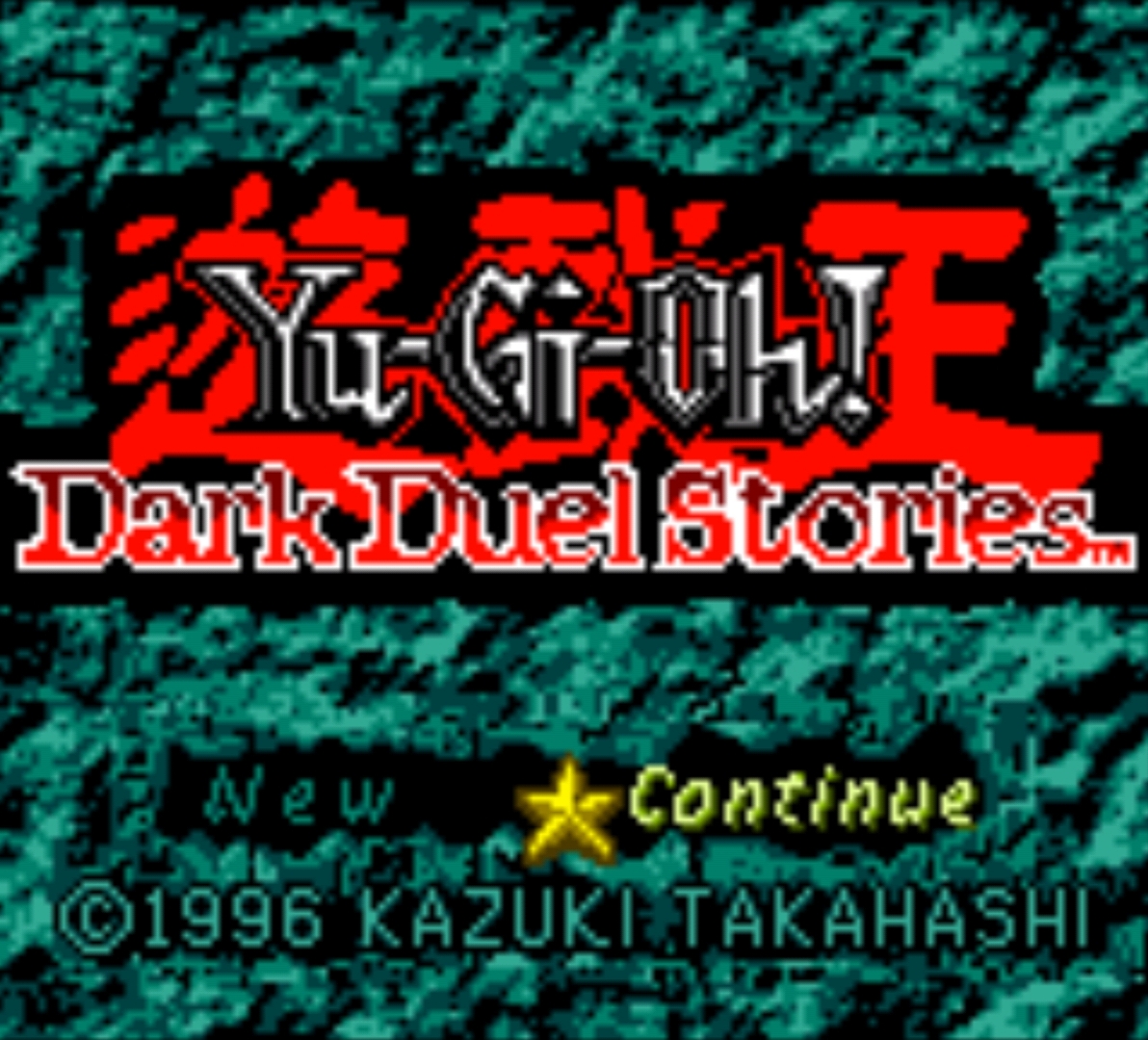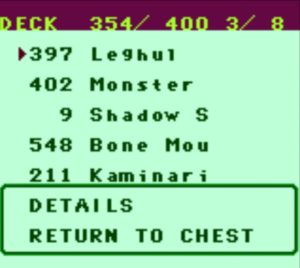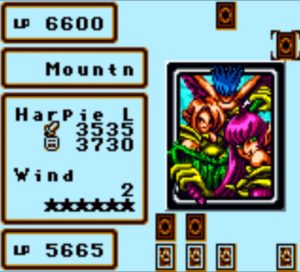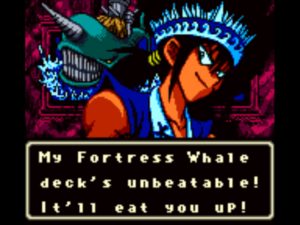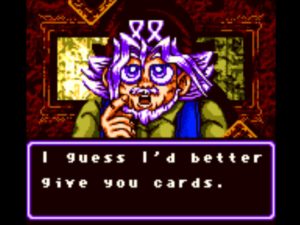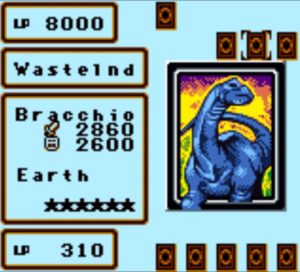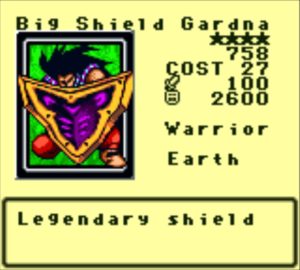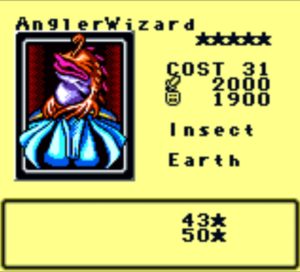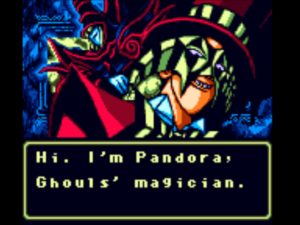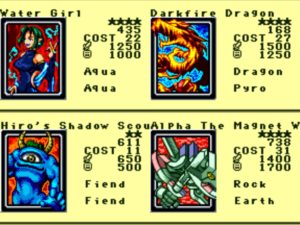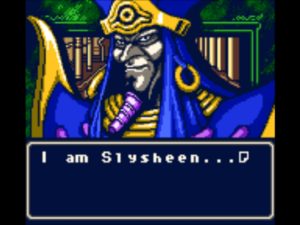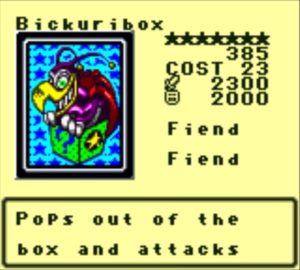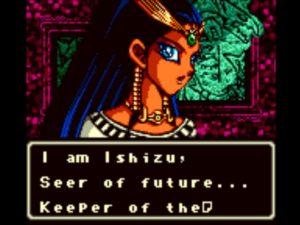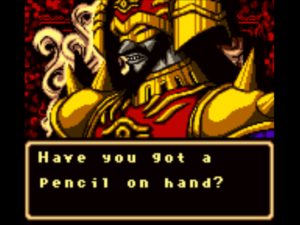Dark Duel Stories came to us late. Very late. Japan got their Duel Monsters III in June 2000; North America received a localised version only in March 2002, and Europe not until March 2003 (!). And because of this time-lag, Dark Duel Stories (DDS) was a loveable yet goofy has-been game as soon as it hit the shelves.
Just released and already a thing of the past? How is that exactly? You see, every so often, the Yu-Gi-Oh Trading Card Game ruleset is rather comprehensively revised. Konami will do something like throwing out a rock-paper-scissors system of elemental weaknesses, or introduce a much expanded trap and magic zone, or completely rewrite the rules of monster effects, that sort of thing. (Or in recent years, develop summoning mechanics and interactions so complex that they require walls of fine print on each card.) Dark Duel Stories (DDS) – alongside four other GBC Yu-Gi-Oh that were never translated – was conceived prior to the codification of Yu-Gi-Oh 2.0.
In 2003, wanting to play the latest rules with the freshest cards, I was equal parts annoyed and bemused about the quirky package that was DDS. So many years on, I’m grateful that DDS made it to the West at all, for it survives as a pleasant historical oddity, a snapshot of an alpha stage in the cardgame’s evolution. Today, Dark Duel Stories is a time capsule to a primeval form of Yu-Gi-Oh, a tried, tested and ultimately abandoned set of ideas. It’s Yu-Gi-Oh, but it absolutely isn’t, and I love it.
—
For the purposes of this retro review, I’m using a fresh save. I will not use passwords to directly obtain cards, which can be done (one of each) without cost in DDS. I will rely solely on the trusty beginner deck capable of reliably beating Tristan and not much else, and build it up through card prizes earned from duel victories. Besides Tristan, there’s Mako and Mai, two other Domino Town 1 duelists who are out of our league for now. Yugi, too, is a tenuous proposition. But Joey we can handle – provided we draw either of our trump cards, Yamatano Dragon Scroll (900/300/2*/WIND) or Frog the Jam (700/500/2*/AQUA), and draw ’em fast, so he doesn’t get to leapfrog to higher summons. Yeah, that’s “Aqua”. For when “Water” simply won’t do.
As our first prize we win a Queen’s Double (300/350/1*/EARTH) from Tristan. Great. Tristan has Exodia pieces on his drop table, but we don’t need those. I battle Joey next. Yamatano is in my opening hand, and we’ve got Joey on the ropes from the get-go. Swordsman of Landstar (500/1200/3*/Light) is our prize. Lucky! I gleefully remove a Leghul from the deck. Swordsman alone walls a lot of what Yugi can throw at us. Or does it?
As I touched upon earlier, DDS uses a system of OHKO type weaknesses that makes it fairly unique in Yugiland. Each card has an elemental affinity. Fire beats Forest, beats Wind, beats Earth, beats Thunder, and so forth. This strategic dimension so essential to Yu-Gi-Oh’s early days is DDS its main gameplay loop, too, as it wants you to put elemental typing front and centre in strategising for your opponent. It so happens that Light is weak to Shadow, so our newly acquired Swordsman will be precious little help against Yugi. Bummer.
To win in DDS you’ll absolutely have to master the type cart, because even Town 1 duellists’ love for tactically-deep monotype decks makes them extremely dangerous. Mai Valentine’s harpy beatdown deck dominates from turn 1, and can have a Harpie’s Pet Dragon (2000/2500/7*/WIND) on the field by turn 3. Mako wastes no time summoning his Fortress Whale (2350/2150/7*/DIVINE) if you permit him two tributes.1Misspelled as “DEVINE” in-game, this element is neutral (no strengths, no weaknesses). Yugi will rush Dark Magician if he can, Joey will field a Red-Eyes Black Dragon. There is an endgame to each opponent’s deck, even the early game duellists from the first screen, while you make do without tributes in your deck and an army of Zone Eaters (250/200/1*/AQUA) and Milus Radiant (300/250/1*/FOREST). DDS is not a game, then, that encourages reliance on brute force. You’re consistently on the back foot – new cards come slowly, one per win, without the ability to source a playset of anything, since there’s no card shop. In DDS, your deck will always be inferior but never uncompetitive, so long as you – ahum – play your cards right.
But we are getting terribly ahead of ourselves. We’ve only just won 2 battles, and we need to defeat everybody 5 times to progress into Town 2. Our first goal is to win Thunder cards essential to beating Mako. We have a few ways to go about this. Tristan, Joey, Yugi and Mai all drop Oscillo Hero #2 (1000/500/3*/THUNDER). Yugi and Mai give Mega Thunderball (750/600/2*/THUNDER), Tristan and Joey LaLa Li-oon, and everyone save Mako himself drops Electric Lizard. Yugi’s drop table in general is packed with goodies like Celtic Guardian, Blackland Fire Dragon, Alpha & Beta the Magnet Warrior, Koumori Dragon, plus a slew of powerful magic and trap cards. All of which will make our lives much, much easier here and well into Town 2, and against Mai, as decent Forest cards are hard to come by early on. We’d also love to pick up an early Dreams card like Joey’s Mystical Sheep #2 to help against pesky Shadow types and counter to Yugi’s Dark Magician. Top prize here is the Mechanicalchacer (1850/850/4*/FIEND), which – should we get it – will be our deck’s backbone all the way though to game’s end.
Fellow novice Tristan is the obvious starting point. After five uneventful duels, we graduate to Joey, whose combo of Wasteland + Mountain Warrior (600/1200/3*/EARTH) immediately puts us through the wringer a few times until we draw Yamatano. After half a dozen duels, we come away with Princess of Tsurugi (900/700/3*/WIND), Fusionist (900/700/3*/FOREST), Armored Lizard (1500/1200/4*/AQUA), and Panther Warrior (2000/1600/6*/SHADOW), our first tribute monster. Lucky! Though we can’t use the latter two until our duellist level is (much!) higher. Hngh.
Yugi comes through for us without hesitation, offering up that coveted Thunder type in the form of Oscillo Hero #2. Nice! On the second duel, I fail to destroy his Flame Viper due to type weakness, and Yugi immediately takes advantage by summing Dark Magician Girl. Powerless to stop it without a Dreams card or tributes of my own, I take a 2-turn loss. We rack up five wins but earn nothing else of note, and take on Mai against my better judgement.
The win condition here is drawing any of Forest-types Bladefly, Gale Dogra, Abyss Flower or preferably the freshly acquired Fusionist. It’s a surprisingly simple formula, because Mai somehow doesn’t run any Fire Pyro types to back her fearsome Harpies up, and unlike Yugi she won’t clear the field with Dark Hole. As such all goes auspiciously, and in five wins we bag a Needle Ball (750/700/2*/FIEND), Winged Cleaver (700/700/2*/FOREST), and The Wandering Doom (800/600/2*/FIEND). Nice, these’ll come in handy. That leaves only Mako, the Neptune of Town 1.
We have precisely *two* Thunder types at this point, stock Kaminarikazou (700/600/2*/THUNDER) and Oscillo Hero #2 Yugi gave us. Luckily for us, all those ~700-800ATK cards we won keep Mako on the defensive, so he can’t hide and set up behind The Melting Red Shadow (500/700) or Serpent Marauder (600/700). In five battles he shows his teeth a few times, powering up various Water types with Sea terrain (Umi) and Power of Kaishin. But we always seem to have Oscillo Hero #2 or Kaminarizou in reserve to save the day. Only to promptly have them taken out by Earth types, of course. (You see that, Mai? Counter the counter!) But it suffices. I worried about the want of draw support at this stage of the game, but thankfully we didn’t need it. We get Sectarian of Secrets (700/500/2*/SHADOW), Phantom Dewan (700/600/2*/SHADOW) and Petit Dragon (600/700/2*/WIND) for our troubles and finish up Town 1.
It’s a real dopamine rush to detail Mako’s Wailord Fortress Whale gameplan so comprehensively using only prize cards earned fair and square. In this shaping of your deck to exploit the opponent’s type weakness(es), is when Dark Duel Stories will click. The central philosophy of DDS is to work with what you have, and in that concept is very finely balanced around itself.
I didn’t always feel this way. In a hasty review of Dark Duel Stories I jotted down well over 10 years ago, I insisted on framing the game’s OHKO type chart as a “fatal flaw”, consumed as I was by Yugioh’s modern ruleset. Time truly is the great revisionist. Back then it somehow didn’t occur to me that DDS, plus all the Japan-exclusive GBC Yugioh titles, follow some primordial, actively evolving set of mechanics. I haven’t explained this in depth yet beyond the elemental type system, but various other differences from modern Yu-Gi-Oh are plain to see. DDS has but one combined slot for magic and trap cards, not five.2Sacred Cards, a Gameboy Advance game in the same elemental type tradition, was the first to feature a full five spaces. DDS doesn’t know monster flip effects, either – just the occasional card ability to activate. And while today’s game sports an ever-growing body of thousands cards, DSS makes do with a meagre 800. In order to enjoy Dark Duel Stories, you absolutely must decouple it mentally from modern notions of Yu-Gi-Oh and experience it on its own terms. This rang true 15 years ago, and still does today.
—
Right. So I moved into Town 2. In what is probably toughest juncture in the game. And sure enough, it took but a one-time trouncing by Pandora to realise I’m a sitting duck without that elusive Dreams card; and one roast at the hands of Weevil’s Perfectly Ultimate Moth to remember that I need Fire cards to respond and spec for him, ie. more Flame Viper (400/450/2*/PYRO) or Charubin the Fire Knight, dropped by Espa Roba. While Town 1 was about countering specific threats from a position of relative comfort as the base power of your cards is usually a notch above your opponent’s, in Town 2 the tables are turned. Espa Roba, Rex, Weevil, Seeker, Pandora, Kaiba – all preface a powerful endgame with strong 4* base summons. We can’t hope to overpower these guys with our current toolkit. That leaves two options: grind out Yugi and hope for that Mechanicalchaser, which’ll give us an all-or-nothing, one-trick-pony method to take wins. Or… We can take on Seeker.
Seeker (“Rare Hunter” elsewhere) may seem like a surprising target at first glance. He’s this game’s ultimate Waller, relying on Dragon Piper (200/1800/3*/PYRO), Stone Statue (300/2000/4*/EARTH) and Gear Golem (800/2200/5*/EARTH) to hold the fort and buy time for (rather weak) offensive tribute summons. However… As you will have gathered, his deck is Earth-based, and Town 1 has blessed us with a number of highly useful Wind cards. Plus we can now run Armored Lizard and tribute summon Panther Warrior. And to sweeten the pot a little more: Seeker’s (poorly mapped!) drop table has a bunch of useful stuff.
In our first battle, Seeker quickly exhausts his two Raigeki. We draw Panther Warrior and get it on the field, and victory is cinched. In incredible stroke of good fortune, our first prize is quite possibly the best card on Seeker’s drop table: High Tide Gyojin (1650/1300/4*/AQUA). That’s a ridiculous impulse to our deck. (On my previous playthrough, I spent forever getting this card!) Second duel we dismantle his defenses with Wind cards, and win again (Master & Expert 1200/1000/4*/FOREST). Going far, far better than I expected. In duel 3 we’re brought to the brink of defeat by Seeker’s tribute summons until High Tide Gyojin turns the, eh, tide. Duel 4 gives Arma Knight (1000/1200/4*/AQUA). In the fifth duel we bait out two Raigeki, use our newly acquired Arma Knight to type-KO his Dragon Piper, and sweep the game. And with surprising swiftness, that’s Seeker done.
As our deck capacity expands diving deeper into Town 2, we can consider making room for a Magic (or Trap) card. These take up a *lot* of space. To Illustrate, we currently sit at 535/555 capacity used, a pool that’ll continue to expand at a rate of 5 per win. Dark Hole, that monster-clearing utility card, consumes 150 capacity points all on its lonesome. It’ll be some time, then, before we can use the likes of Brain Control, Swords of Revealing Light and Raigeki. Trap cards are cheaper, so we’ll start there.
The best method of accumulating Magic, Trap and Ritual cards is through Yugi’s dear grandad, Solomon. In most games, Solomon runs a card shop or is a duellist himself. Here, he’s a password unlock who helpfully provides one extra card per win. The vast majority of these are underpowered monsters or niche Magic such as Power of Kaishin and Electro-Whip that Mako and Mai use to reinforce their monotype decks, but occasionally he’ll grant something truly useful. It pays to get an early start.
Our next target is Rex. He’s an all-offensive Earth user countered effectively by Wind, save for a few strong Fiends we have only a single answer to: High Tide Gyojin. …And we receive a rude awakening. In the first duel, on turn 2, Rex tribute summons Pragtigal (1900/1500/5*/EARTH),3 Known as Pragtical, with a second c, elsewhere. puts down Wasteland, uses two Raise Body Heat, and crushes my Bladefly with a boosted 3470ATK. Helpless without a Wind card, we get stomped. Rex reassures me he’s “here anytime I want to lose”. Thanks, pal. I try again, and lose in similar fashion.
Brilliant. I would love to get another Yamatano Dragon Scroll, not just because of its Wind affinity, but because Yamatano is DDS’ undisputed king of fusions, capable of merging with just about any low-level monster to create a bunch of different dragons. Now, modern Yu-Gi-Oh taught us that fusions are purplish special cards requiring Polymerization magic to be put into play. Not here. Summon one card on top of another and game will automatically conjoin them if a combination exists. You can even do this within your hand. It takes trial and error to discover useful combinations, which, when found, are a decent alternate way of getting power onto the playmat when 4* monsters are in short supply. A whopping 28314 potential fusions exist in DDS – I kid you not – and we simply have to take advantage. We can even make Harpy’s Pet Dragon this way if we can get our hands on a Harpy Lady! And so I paid Mai another visit.
Two losses to turbocharged 2690ATK Harpie Lady and 13 wins ensue, including an 70LP close call and a round where she memorably got a turn 1 godhand to instantly put a triple-powered up Harpie Lady Sisters on the field… Only to suicide into my face-down Master & Expert (Forest beats Wind). Pickings are slim and we win no Harpies, though we do grab Brain Control for (distant) future use, Fire Eye (800/600/2*/PYRO) that’s handy versus Weevil, and a surprise Cannon Soldier (1400/1300/4*/FIEND) and badly-needed Genin (600/900/3*/DREAMS) from Solomon. Mildly disappointed, I relent and switch to duelling Yugi instead. There’s no chance of a Harpy Lady here, but that’s okay, for an alternate solution presents itself when, in quick succession, we snag Blackland Fire Dragon (1500/800/4*/SHADOW) and Big Shield Gardna (100/2600/4*/EARTH), an utterly broken waller-staller card that stops dead in its tracks anything Rex throws at us. I’ll take it!
Hi Rex, I’m back! From the safety of Big Shield, we can wait for Wind cards and big hitters like High Tide to filter through, then strike. Our strategy thus revolutionised, we take 5 wins in 6 duels. Even his powered up Little D can’t stop us. If only I had Dark Tit in this deck. That’s Little Dinosaur and Dark Titan of Terror, by the way, delightfully abridged on the field of battle due to character limitations. Uraby (1500/800/4*/EARTH) and Dark King of the Abyss (1200/800/2*/SHADOW) are welcome additions.
Weevil is next. His insects pack a punch, so Pyros are the solution here. Weevil’s secret weapon is 2000DEF Cocoon of Evolution, which if left undisturbed will pupate into Great Moth (2600/2500/8*/FOREST) and Perfectly Ultimate Great Moth (3500/3000/8*/FOREST) another turn later that overpowers even Big Shield. We can’t yet counter through field clear or traps, so we absolutely must expand our repertoire beyond Fire Eye. Options however are limited: Flame Viper from Yugi, Charubin the Fire Knight from Espa Roba, and in theory, Darkfire Dragon from Kaiba the still-unbeatable. So back to Yugi we go, who promptly gives me Beta the Magnet Warrior (1700/1600/4*/EARTH), Feral Imp (1300/1400/4*/FIEND) and Chronolord (800/900/3*/DREAMS).4If it wasn’t apparent already, Yugi’s drop table is incredibly good at this stage of the game, the reason why I battled him over 50 (!) times on a previous playthrough. Despite repeatedly taunting me by fielding multiple Flame Vipers, he won’t fork over a copy. Then in a sudden expression of compassion, grandad gives me ultimate beatstick Mechanicalchacer, and suddenly there’s no Weevil bug we can’t squish (except Cocoon).
I could, of course, have taken a shortcut to a Pyro type by building my own. You see, a “card part for construction!” is earned after every battle. The game has a few dozen of these top-half and bottom-half parts that combine in modular fashion to create an astonishing 9800 possible composite cards. Some are absolutely off-the-charts, gamebreakingly overpowered, and all tend to bear rather silly names with looks to match, which are the two reasons why I won’t touch them. Take the AnglerWizard, a hideous toad-frog thing in a dress, or the charmingly named CornfieldChariot, which happens to be ridiculously powerful (2000/1300/3*/FIEND). Or our friend Bell BillCount, a cheap as chips 3* card with 2000ATK and 2000DEF. Card construction is an ingenious novelty… And something I absolutely do not want to exist in my (proto) Yu-Gi-Oh game. If I could mod the entire system out, I would. I’m just relieved the AI doesn’t use these monstrosities.
—
We take on Weevil with renewed vigour. Cocoon of Evolution being played still results in inevitable defeat when Fire Eye isn’t available to counter, but more often than not he either is, or we drain Weevil’s LP before he pulls it. Weevil’s nasty buggers get us twice (including a double Perfect Moth game, yikes) until we crush them insects for good. We get Beastking of the Swamp (1000/1100/4*/EARTH) for our efforts, a card notable for its pocket Dark Hole-effect. Very nice.
Self-styled “telepathic genius” Roba relies on Reflect Bounder (1700/1000/4*/FIEND) and niche Thunder fusions that we hard-counter with Beta the Magnet Warrior, Uraby, Mountain Warrior, Beastking and Trakadon (from Weevil). Conceptually I like his deck, but we’re well-equipped to handle it. The greater danger is of a protracted stalemate pitting Big Shield Gardna against The Fiend Megacyber (2200/1200/6*/FIEND) that can be broken only when Beastking or a Light type is finally drawn. We deck out once on the way to five victories… And cruelly earn three Pyro cards, Charubin the Fire Knight (1100/800/3*/PYRO) plus two others I had overlooked, Dissolverock (900/1000/3*/PYRO) and Flame Ghost (1000/800/3*/PYRO). …Yeah. In retrospect we should’ve gone after Roba first. Oops.
That leaves only Pandora and Kaiba. Pandora (or Arkana) loves his Shadow decks with a dollop of Fiend mixed in. So long as we draw our heavy-hitters, with Dreams and Light types in reserve to help us out of tight spots, we haven’t much to fear… Discounting Pandora’s Jokeresque appearance, and the rooftop he might dangle us from should we win. If we don’t draw those cards, we lose. Our deck is 30% decent 4* cards at this point and 70% underpowered holdovers, so we’re relying on a minority share to carry us. In the end, we come out ahead with 5 wins to 2 losses and shore up our deck with Brave Scizzar (1300/1000/4*/FIEND) and Invisible Wire, a highly playable, cheap single-use Trap card that destroys an attacking monster with <2000ATK. We also win a Raigeki, the game’s best Magic card by some distance, but lack the deck the capacity to use it. We will though, soon enough.
And then for Town 2’s apotheosis, the mid-game’s formidable final boss and gatekeeper to Ancient Egypt (“Town 3”): Kaiba. Kaiba begins the introductory pleasantries by announcing confidently this’ll “be the end of my winning streak”. And he’s not wrong. Kaiba’s got the archetypal balanced deck, making for a fairly elegant checkerboard of beatsticks and counters, headlined by La Jinn and Battle Ox that put us at a serious power deficit. Given the right opportunity he will bring out Swordstalker (2000/1600/6*/SHADOW), Judge Man (2200/1500/6*/LIGHT) and even Blue-Eyes White Dragon (3000/2500/8*/LIGHT). We have what he has, only weaker, so for us to win, the dominoes need to fall just right. And somehow they do – twice – before we lose four times on the trot. Then I realise Kaiba lacks field clear and Shadow counters, so putting Panther Warrior in play guarantees a win. We finish the series 5-4.
I’ve talked about card stats a lot in this review and shown off many, many portraits. Not just because DDS is fundamentally a game about cards (you don’t say!), but also because the art is downright fantastic. The game’s brooding, intimidating close-up portrait style monster cards are often ruggedly monstrous and positively Lovecraftian. I particularly like the depictions of Alpha Magnet Warrior, which looks like it’s about to launch itself at you, the bewitchingly attractive Water Girl, mesmerisingly robotic Mechanicalchacer, fiery serpent Darkfire Dragon, armed-and-ready Versago the Destroyer, mystical Maha Vailo, and uncharacteristically huggable Hiro’s Shadow Scout. I think all of DDS’ cards are original assets inspired by the manga and created specifically for the Duel Monsters Gameboy games, the first of which was released in December 1998. The original TCG series (from 1999) certainly uses some these artworks but far from all. Either way I’m smitten with DDS its card art. It’s quite subtle how a hand resting on a card border makes monsters pop from the frame, lending a sense of depth and perspective to an otherwise static image. It really breathes life into the creatures.
We are woefully unprepared for Town 3. All duellists in this area rely on Light, Shadow, Dreams and Fiend cards to varying degrees. We have one great Fiend (Mechanicalchacer), an okay Shadow (Blackland Fire Dragon), three weak Dreams cards and hardly any Light at all. We can’t even run Raigeki! It’s a recipe for disaster, but I like to bake, so… Here goes.
Ishizu Ishtar is far and away the strongest duellist in Ancient Egypt, followed by Paradox (Moran) and Seto. Versus Heishin (Slysheen) we may have a fighting chance. He seeks “power to conquer the world”, but beat him 5 times and we instantly save it, he says. Thank Ra for that. However, it’s soon apparent that I underestimated him. His Mask of Shine & Darkness (2000/1800/6*/DIVINE) is a recurring problem we have no answer to but Invisible Wire or Beastking. He likes to power it up, too, putting it out of Wire’s reach. This makes us incredibly dependent on our starting hand, but even when it’s good, Slysheen has three copies of Swords of Revealing Light to stall and play Mask, and multiple Raigeki to destroy our beatsticks. (Swords is a Magic card that keeps the opposing player from attacking for 3 turns.) We lose thrice without a snowball’s chance in hell of victory, and it’s painfully obvious that our card pool, deck capacity and duellist level all need expanding. This is as far as mere strategy, gall and tenacity take us. We need the goods. So back to Kaiba we go.
And Kaiba we camp for a goody while. Anything with an ATK rating in the mid-1000s, which’ll go over common turn 1 defence barriers such as 1200 and 1600, will help eke out an advantage. As cards like Violent Rain (1550/800/4*/WATER) and Fairy’s Gift (1400/1000/4*/FOREST) replace Laughing Plant (900/500) and Mushroom Man (800/600), we bulk out nicely. But the top prizes here are Light and Shadow types, and we duel, and duel, and duel until we get them. Grandpa gives us an invaluable second Mechanicalchacer to brighten up our day (and prospects), and then the big kahunas start rolling in: Shining Friendship (1300/1100/4*/LIGHT), Guardian of the Throne Room (1650/1600/4*/LIGHT) and finally, after 20-odd battles, La Jinn (1800/1000/4*/SHADOW), our phosphorescent one-stop solution to anything Light. Then we beat up on Seeker until we get All-Seeing Goddess (1200/1000/4*/LIGHT). Now, we’re ready. Sort of.
‘Sup Charlie Sheen, I’m back. We run Widespread Ruin and our own Raigeki now! Yeah. How d’you like that! … Slysheen doesn’t seem to mind all that much, for we suffer three more closely contested losses before, at long last, taking a victory. Which means we’ve entered the realm of statistical possibility of winning, if not yet probability. In trading blows, his deck’s overarching theme finally becomes apparent: toon types. Yup, Slysheen’s a Pegasus knock-off, rocking an end-game of Toon Alligator, Toon Summoned Skull, Manga Ryu-Ran and Bickuribox. Success and defeat alternate until we hit 5 total wins, and Slysheen tells us we’re lucky to escape ritual sacrifice. What a jerk. But we don’t care. We bag Toon Summoned Skull (2500/1200/6*/FIEND) and leave to face our next foe: Paradox.
…Whose opening play is to play nothing at all, then Brain Control my Mechanicalchacer, tribute it and put Orion the Battle King (1800/1500/5*/LIGHT) into play, powered up with Bright Castle for good measure. We Raigeki it. He responds by throwing Magic after Magic at me: Crush Card (destroys all monsters in play whose ATK>=1500), Spellbinding Circle (lowers all enemy monster stats by 500), then healing back up with Dian Keto (restores 5000 LP). Then Spellbinding Circle twice more, but thankfully monsters can’t be reduced further than one stage. We survive this barrage, and win. That was… Easy. This first duel becomes emblematic, as we continue to thrash him. I’m not sure why. Perhaps because his AI is a bit busted. He likes to play Crush Card when no monsters are on the field, so it does nothing and goes to waste, and uses Dian Kato when at full Life Points (8000), but as LP caps at 9999 in this game, 3000 of it regularly goes to waste. In duel 3 Paradox shows his class by putting a doubly powered up Dark Witch into play (of Light alignment, paradoxically… ha) through a clever Brain Control combo. But that’s 4 cards blown in a single turn, leaving him with an empty bench when Saggi the Dark Clown (600/1500/4*/SHADOW) takes out the Witch, and he’s done for. We counter his superb Light cards pretty hard, and he’s nowhere near the threat Slysheen was. We win five without dropping any.
Next up is P. Seto. P for Priest, I think? At the core, she has a well-rounded deck of interlocking elemental affinities. On top she runs 3 copies of universal power-up card Megamorph, 3 Raigeki, 3 Dark Hole, and triple Change of Heart, which is a permanent Brain Control. When she draws her Magic, she’s unstoppable; in simply trading blows, however, she’s vulnerable. We win a few times, and earn a card I’ve always wanted in this game, but never actually gotten: Dark Elf (2000/800/4*/SHADOW). This card was retrobalanced in the TCG to consume 1000 life points per attack. Here in DDS, it has no drawbacks at all, save for perhaps its Shadow typing.
..Which makes it both an asset and a liability against Ancient Egypt’s supremo. Ishizu runs a finely-crafted beatdown deck that pivots on Light types complemented by Shadow and Dreams, eschewing Fiend. Heavy-hitters Gemini Elf (1900/900/4*/LIGHT), Dunames Dark Witch (1800/1050/4*/LIGHT) and – you guessed it – Dark Elf are the headliners, backed by Swords of Revealing Light, Spellbinding Circle and Dark Hole to stall out the opponent when necessary. Swords cannot be countered, only waited out. I’m Incredibly thankful to have Light-counters Dark Elf, La Jinn and Blackland for this series of duels, who can destroy Gemini Elf and Dunames and instantly go on the offensive. In the seven games it takes to get five wins, she snowballs to summon Cosmo Queen (2950/2400/8*/DIVINE) only twice. Our reward is 7 Colored Fish (1800/80/4*/WATER).
And that’s it for DDS! Or is it? Not quite. There’s still DarkNite, the game’s final boss who looks as though he stumbled into a ceremonial suit of armour on his way to a fancy-dress party. He commends us for coming a “long and perilous way”, and surprisingly doesn’t want anything from us, just five wins so he’s allowed to share a password. Are you disappointed the final confrontation is about an 8-digit code? I know I was. His deck’s a twist on Ishizu’s, her Light powerhouses replaced by Jirai Gumo (2200/100/4*/FOREST), a card that sees little play in the TCG due to a suicidal side-effect but is this game’s ultimate uppercutter, and Reflect Bounder (1700/100/4*/FIEND). DarkNite’s eclectic mix of Magic is the real danger, as he’ll blast you with Raigeki, Brain Control, Change of Heart, Swords and most viciously, Shadow Spell, which inflicts a negative -1000ATK/DEF modifier on all enemy monsters. The key is to play around his Magic, letting him exhaust his spells on cards you can afford to lose. It helps that his AI is a bit wonky too – on one occasion, he used two Megamorph on a brain-controlled Armored Lizard that I got back then turn after. Uhh, thanks, pal! In the end, we bag a Jirai Gumo to win five and lose only once. After more compliments that a “mere mortal” somehow defeated a gilded cyborg five times, the game’s penultimate line is “Have you got a pencil on hand?” How I love you, y2k.
And with that, Dark Duel Stories *does* draw to a close. DarkNite’s password, by the way, unlocks the credit roll (no joke) but also provides access to Yami Yugi, the first of the game’s optional duellists that also include Yami Bakura, Shadi, NiteMare and Marik. All of these guys are true password unlocks, and I’ll let you explore those for yourself by attaching my save at the bottom of this post so you can continue with this deck, should you wish. (The duellist name is easily changed from ChronoCC on the main menu.) Passwords are there too – just bear in mind that Yami Yugi needs to be defeated five times in order to battle the others.
All in all we fought 177 duels: 57 in Town 1, 84 in Town 2, 30 in Town 3, and 6 against DarkNite. Of these we won 149 and lost 28. We earned every card fair and square, and have many powerful Magics on hand we can’t yet use due to deck capacity, most notably Megamorph, Change of Heart and Swords.
I was truly amazed to tally close to 200 duels, which had flown by. Dark Duel Stories has an almost gacha-like quality to it in its one more duel to win one more card addictiveness. Do I have nostalgia for this game? Absolutely. Could I have merrily spent so many hours with it had the game been an ungratifying mess? Absolutely not. Do I think you ought to dip your toes into Dark Duel Stories to sample Yu-Gi-Oh’s humble, all-but-forgotten roots? I most definitely do. And is there fun to be had doing so? Oh yes.
For you deck enthusiasts, here is a full rundown of its final composition.
Toon Summoned Skull (2500/1200/6*/FIEND)
Panther Warrior (2000/1600/6*/SHADOW)
Jirai Gumo (2200/100/4*/FOREST)
Dark Elf (2000/800/4*/SHADOW)
Mechanicalchacer x2 (1850/800/4*/FIEND)
La Jinn the Mystical Genie (1800/1000/4*/SHADOW)
7 Colored Fish (1800/800/4*/AQUA)
Beta the Magnet Warrior (1700/1600/4*/EARTH)
Guardian of the Throne Room (1650/1600/4*/LIGHT)
High Tide Gyojin (1650/1300/4*/AQUA)
Violent Rain (1550/800/4*/AQUA)
Armored Lizard (1500/1200/4*/AQUA)
Takriminos (1500/1200/4*/AQUA)
Blackland Fire Dragon (1500/800/4*/SHADOW)
Uraby (1500/800/4*/EARTH)
Cannon Soldier (1400/1300/4*/FIEND)
Water Omotics (1400/1200/4*/AQUA)
Spirit of the Book (1400/1200/4*/WIND)
Fairy’s Gift x2 (1400/1000/4*/FOREST)
Feral Imp (1300/1400/4*/FIEND)
Shining Friendship (1300/1100/4*/LIGHT)
Brave Scizzar (1300/1000/4*/FIEND)
Trakadon (1300/800/3*/EARTH)
Lesser Demon (1200/1000/4*/FIEND)
All-Seeing Goddess (1200/1000/4*/LIGHT)
Dark King of the Abyss (1200/800/3*/SHADOW)
Versago the Destroyer (1100/900/3*/SHADOW)
Charubin the Fire Knight (1100/800/3*/FIRE)
Beastking of the Swamp (1000/1100/4*/EARTH)
Flame Ghost (1000/800/3*/PYRO)
Invader from Another Galaxy (950/1400/4*/DREAMS)
Golgoil (900/1600/4*/DREAMS)
Dissolverock (900/1000/3*/PYRO)
Big Shield Gardna (100/2600/4*/EARTH)
Invisible Wire x2
Widespread Ruin
Raigeki
And as promised, the passwords and save.
Passwords:
Yami Bakura | 07119986
Nitemare | 43504084
Shadi | 70592699
Marik | 06987398
Save file (US version):
ChronoCC Dark Duel Stories
I do not and will not provide ROMs. Please don’t ask.

